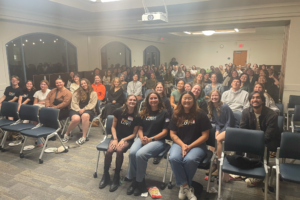By the time this was written on November 11, the Gun Violence Archive cites 308 mass shootings that have occurred in the United States in 2018. It’s unfortunate that I need to preface that with a date, but because of how common these events have become, it feels necessary. According to the FBI, a mass shooting is an event where four or more individuals (not including the shooter) are shot and/or killed.
Unfortunately, active shooters are not the only violent events popping up in headlines. Acts of terror, bomb threats and other security risks seem to be populating our news feeds ever more frequently. Karl Martin, a professor of literature at PLNU, reflects on how things have changed throughout his lifetime saying, “There was serial killers and violence, but there wasn’t the kind of mass violence in a moment [like] a guy with a semiautomatic weapon. People didn’t have that kind of firepower. The level of destruction was much lower.”
PLNU’s campus experienced an unspecified threat on October 25th, which led to the cancellation of classes and a law enforcement investigation. Whitney Byrd, a senior writing major, says, “From what I could tell there were several moods on campus. Some took the threat completely seriously and began to get anxious and physically react, others acted as if it was just another free day and didn’t even give the threat a second thought.”
The campus resumed normal operations the next day, however, Kaz Trypuc, PLNU Public Safety Supervisor, says, “Every time that one of these events occurs, my sense is that more people take the issue more seriously.”
An additional variable to these types of events is the technologically driven ways we consume our news. When a notification about a mass shooting is the first thing you see upon opening your eyes in the morning, it can be jarring. Martin says, “It comes at us in very personal ways, because it’s on the device that’s on our person, and it comes to us in undifferentiated ways that we don’t fully control.”
The Smithsonian Magazine describes what occurs in the brain when an individual is faced with fear: “A threat stimulus, such as the sight of a predator, triggers a fear response in the amygdala, which activates areas involved in preparation for motor functions involved in fight or flight. It also triggers release of stress hormones and sympathetic nervous system.”
According to Daniel Jenkins, a PLNU professor of psychology, “We know that chronic stress [and fear] impacts the whole person in many ways. Stress ages us prematurely, increases anxiety, and makes us vulnerable to various diseases.” He goes on to share that the unexpected nature of these events of mass violence can increase our fear response to them, which leads to heightened anxiety because of a perceived lack of control.
Jenkins says that realistically, the chances of being harmed in one of these horrific instances are very low and the “fear response can be mediated by the knowledge that you are being cared for and that everything is being done to keep you safe.”









Add Comment